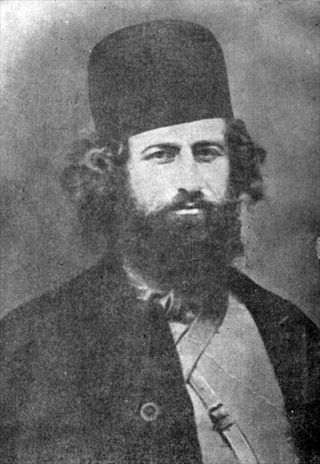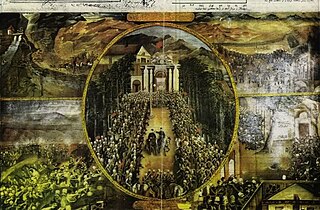Related Research Articles

Gilan province is one of the 31 provinces of Iran, in the northwest of the country. Its capital is the city of Rasht. The province lies along the Caspian Sea, in Iran's Region 3, west of the province of Mazandaran, east of the province of Ardabil, and north of the provinces of Zanjan and Qazvin. It borders Azerbaijan in the north.

Mohammad Ali Shah Qajar was the sixth shah of the Qajar dynasty and remained the Shah of Iran from 8 January 1907 until being deposed on 16 July 1909. He was furthermore the grandson of Iran’s early moderniser Amir Kabir, through maternal side.

Howard Conklin Baskerville was an American missionary teacher. His life ambition was to become a pastor. He worked as a teacher employed by the American missionaries at the American Memorial School in Tabriz, a Presbyterian mission school, and was killed during the Persian constitutional revolution in an attempt to break the siege of Tabriz. He is often referred to as the "American Lafayette of Iran" and the "American Martyr of the Iranian Constitutional Movement".

Sattar Khan, honorarily titled Sardār-e Melli was a pivotal figure in the Iranian Constitutional Revolution and is considered a national hero by the Iranian people.

Mirza Kuchik Khan was an Iranian twentieth-century revolutionary leader and the president of the Gilan Socialist Soviet Republic. He was the founder of a revolutionary movement based in the forests of Gilan in northern Iran that became known as the Nehzat-e Jangal . This uprising started in 1914 and remained active against internal and foreign enemies until 1921 when the movement was completely abandoned after the demise of Mirza Kuchak Khan.

Sardar Asaad Bakhtiari, also known as Haj Ali-Gholi Khan, Sardar Asaad II was an Iranian revolutionary and a chieftain of the Bakhtiari Haft Lang tribe. The third son of Hossein Gholi Khan Ilkhani, he was one of the primary figures of the Persian Constitutional Revolution. He was the brother of Najaf-Qoli Khan Bakhtiari Samsam Ol-Saltaneh, Bibi Maryam Bakhtiari Sardar Bibi, and Khorou Khan Bakhtiari Sardar Zafar.

Yeprem Khan, born Yeprem Davidyan, was an Iranian-Armenian member of the Armenian Revolutionary Federation (ARF), revolutionary leader and a leading figure in the Constitutional Revolution of Iran.

Mohammad-Vali Khan, Khalatbari Tonekāboni ; 1846 – 18 September 1926), known as Sepahdar A'zam, was the leader of the constitutionalist revolutionary forces from Iran's northern provinces of Gilan and Mazandaran and known as one of the greatest statesmen and military commanders of Iranian history as well as its wealthiest nobleman.

The Persian Constitutional Revolution, also known as the Constitutional Revolution of Iran, took place between 1905 and 1911 during the Qajar dynasty. The revolution led to the establishment of a parliament in Persia (Iran), and has been called an "epoch-making episode in the modern history of Persia".

Haydar Khan Amo-oghliTariverdi was an Iranian left-wing revolutionary, key figure during the Persian Constitutional Revolution and among the founders of the Communist Party of Persia.
Sardar Rafie Yanehsari (1856-1930) was the Wali of velayat of Astarabad and Governor of Gorgan from the time of Naser el-Din Shah to Reza Shah and was a member of Yanehsari Dynasty. Sardar Rafi played a major role in the development of the areas under his rule, the first explorations in Gorgan, the first carvings in Tepe Hisar, the construction of the road between Gorgan and Tehran and the introduction of modern science to Gorgan, Only part of his activity was during his 39 years of rule. Sardar Rafi first came to power in February 1892, when he was succeeded by his father, Lotf Ali Khan Sartip, who ruled the Hezarjarib region and rose to the rank of brigadier general. In addition to his services to modernize the areas under his rule, he and his nephew, Amir Khan-e Sardar, played an important role in suppressing Turkmen insurgency.

The Triumph of Tehran refers to the entrance of the pro-constitutionalists in Tehran on 13 July 1909, which led Mohammad Ali Shah Qajar to seek refuge at the Russian legation in Tehran, before he was sent in exile. The event ended the period in Iranian history known as the minor tyranny.
Secret Center was a revolutionary organization established in October 1906. Based in Tabriz, it played an important role in the Persian Constitutional Revolution. It had close ties to the Social Democratic Party.
Siege of Tabriz (1908–1909) took place during the Persian Constitutional Revolution, when which forces affiliated with Mohammad Ali Shah, besieged Tabriz for 11 months to suppress the constitutionalists and prevent food and medicine from reaching the city. Eventually the siege ended with the intervention of Russian forces and the escape and dispersal of the constitutional leaders and mujahideen. This uprising is one of the most important and influential events in the Iranian constitutional movement.

The Atabak Park Incident was a conflict that led to the death of 300 rebels. It took place on July 20, 1910. Rebels descended upon Atabak Garden in Tehran to bid farewell to Sattar Khan and Baqir Khan who were planning to return to Tabriz. The government's goal was to control Azerbaijan and disarm the Mujahideen in Tabriz under the pretext of celebrating Sattar Khan and Baqir Khan. Atabak Garden was allocated to Sattar Khan and his companions and Eshrat Abad to Baqir Khan and his companions.

The Iranian Enlightenment, sometimes called the first generation of intellectual movements in Iran, brought new ideas into traditional Iranian society from the mid-nineteenth to the early twentieth century. During the rule of the Qajar dynasty, and especially after the defeat of Iran in its war with the Russian Empire, cultural exchanges led to the formation of new ideas among the educated class of Iran.The establishment of Dar ul-Fonun, the first modern university in Iran and the arrival of foreign professors, caused the thoughts of European thinkers to enter Iran, followed by the first signs of enlightenment and intellectual movements in Iran.

The Imperial Russian involvement in the Persian Constitutional Revolution was to support the authoritarian faction led by Mohammad Ali Shah to defeat the constitutionalists. Until 20 April 1909, when the Russian army under Major General I. Snarsky occupied Tabriz to protect the Russian consuls, the Russian Empire indirectly supported Ali Shah and the authoritarian faction. Support from the Russian Empire included sending weapons, lending money to Colonel Vladimir Liakhov, the commander of the Persian Cossack Brigade, and a large-scale propaganda machine against the constitutionalist leaders.

Mujahideen of Saturday is a term used by Ahmad Kasravi and Mehdi Malekzadeh in their books of History of the Iranian Constitutional Revolution. Originally, this term mention those politicians who weren't Constitutionalists in Persian Constitutional Revolution but when Mohammad Ali Shah deposed, Suddenly they changed their faction. Two examples that Kasravi and Malekzadeh used for this term was Qavam os-Saltaneh and Vossug ed Dowleh, two brother that in Constitutional Revolution were in Authoritarians faction but after triumph of Tehran, they became Constitutionalists and became prime ministers in Ahmad Shah reign.

The Minor Tyranny was a roughly one year long period in Iranian history lasting from the bombardment of the Iranian parliament by the forces of Mohammad Ali Shah on 23 June 1908 to the capture of Tehran by the revolutionary forces on 13 July 1909. This period was marked by the executions and expulsion of many journalists and constitutionalists as an era of absolutism returned to the country.

The Khanate of Kargan-Rud, also known as Karganrud or Korganrud, was the largest and northernmost of the Khamsa of Talish.
References
- 1 2 3 4 5 6 7 8 علی حقشناس، مقاله/ جنبش جنگل، برآیند مشروطۀ ناکام.خبرگزاری اوج نیوز، آذر ۱۳۹۰.
- ↑ Browne, Edward (1910). The Persian revolution of 1905-1909. pp. 267.